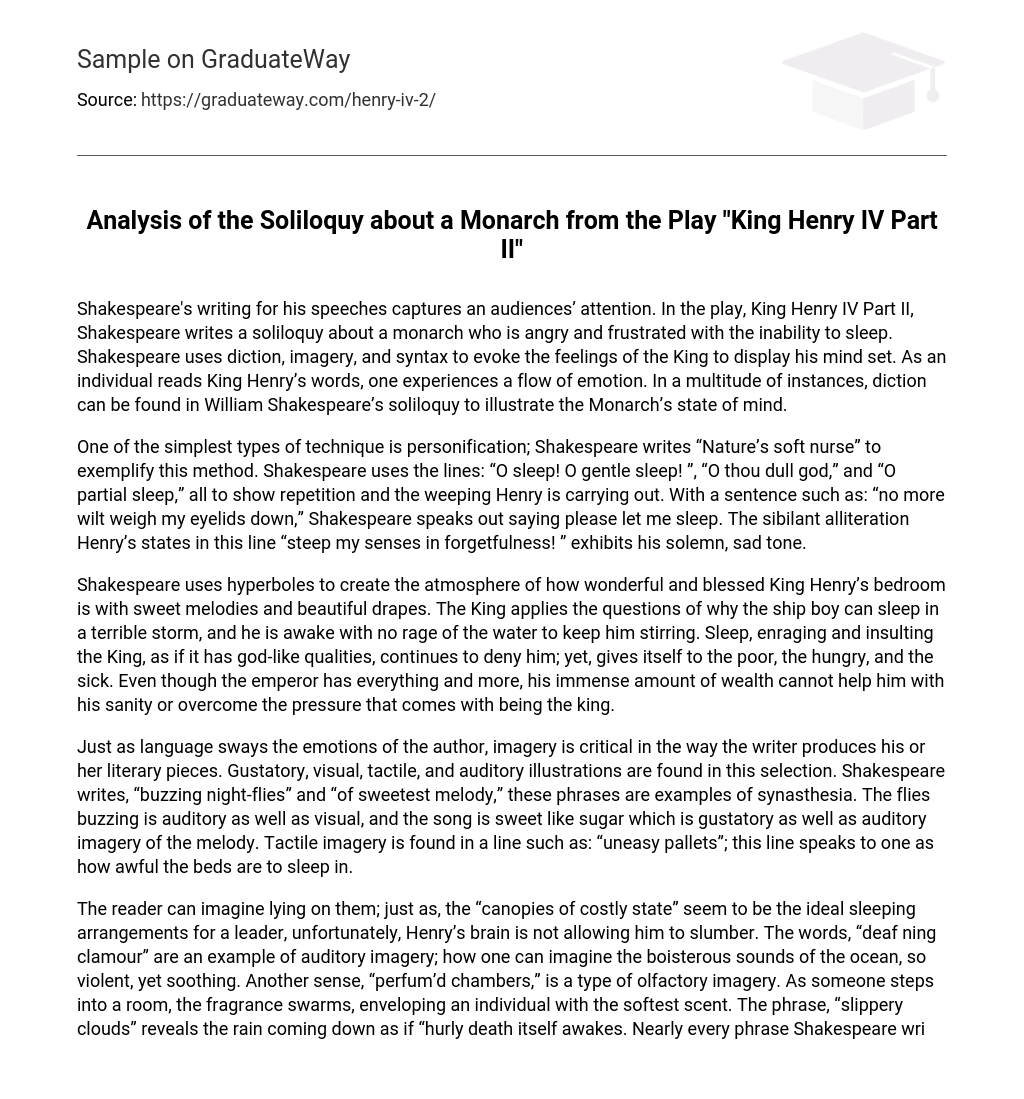Shakespeare’s writing for his speeches captures an audiences’ attention. In the play, King Henry IV Part II, Shakespeare writes a soliloquy about a monarch who is angry and frustrated with the inability to sleep. Shakespeare uses diction, imagery, and syntax to evoke the feelings of the King to display his mind set. As an individual reads King Henry’s words, one experiences a flow of emotion. In a multitude of instances, diction can be found in William Shakespeare’s soliloquy to illustrate the Monarch’s state of mind.
One of the simplest types of technique is personification; Shakespeare writes “Nature’s soft nurse” to exemplify this method. Shakespeare uses the lines: “O sleep! O gentle sleep! ”, “O thou dull god,” and “O partial sleep,” all to show repetition and the weeping Henry is carrying out. With a sentence such as: “no more wilt weigh my eyelids down,” Shakespeare speaks out saying please let me sleep. The sibilant alliteration Henry’s states in this line “steep my senses in forgetfulness! ” exhibits his solemn, sad tone.
Shakespeare uses hyperboles to create the atmosphere of how wonderful and blessed King Henry’s bedroom is with sweet melodies and beautiful drapes. The King applies the questions of why the ship boy can sleep in a terrible storm, and he is awake with no rage of the water to keep him stirring. Sleep, enraging and insulting the King, as if it has god-like qualities, continues to deny him; yet, gives itself to the poor, the hungry, and the sick. Even though the emperor has everything and more, his immense amount of wealth cannot help him with his sanity or overcome the pressure that comes with being the king.
Just as language sways the emotions of the author, imagery is critical in the way the writer produces his or her literary pieces. Gustatory, visual, tactile, and auditory illustrations are found in this selection. Shakespeare writes, “buzzing night-flies” and “of sweetest melody,” these phrases are examples of synasthesia. The flies buzzing is auditory as well as visual, and the song is sweet like sugar which is gustatory as well as auditory imagery of the melody. Tactile imagery is found in a line such as: “uneasy pallets”; this line speaks to one as how awful the beds are to sleep in.
The reader can imagine lying on them; just as, the “canopies of costly state” seem to be the ideal sleeping arrangements for a leader, unfortunately, Henry’s brain is not allowing him to slumber. The words, “deaf ning clamour” are an example of auditory imagery; how one can imagine the boisterous sounds of the ocean, so violent, yet soothing. Another sense, “perfum’d chambers,” is a type of olfactory imagery. As someone steps into a room, the fragrance swarms, enveloping an individual with the softest scent. The phrase, “slippery clouds” reveals the rain coming down as if “hurly death itself awakes. Nearly every phrase Shakespeare writes has a deep, inner meaning to it, wether the reader understands the symbol is left up to him or her. Along with impeccable imagery and articulate diction, Shakespeare uses syntax to explain the mind set of King Henry and tie together the soliloquy. Shakespeare uses complex sentences to achieve the utmost powerful diction. In lines three through six, Henry cries out to ‘Sleep’ to assist him to lay down so he can forget. The ruler’s exclamatory statements like: “Why rather, sleep, liest thou in smoky cribs! ” communicates his dissatisfaction and loathing of slumber.
Questions mock the king: he continues to ask the uncertain why the peasants can sleep, even with the buzzing of night flies, yet he has no ability to shut his eyes. All writing must end with a particular style; Shakespeare utilizes inversion to end the poem: “Uneasy lies the head that wears the crown. ” Without a doubt, Shakespeare’s use of sentence structure is flawless in displaying Henry’s ideal sense. In this soliloquy, stress keeps one up for an eternity. King Henry demonstrates his fury for ‘sleep’ using diction, imagery, and syntax. Shakespeare exemplifies the disturbed mind of King Henry.





